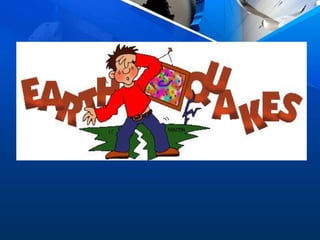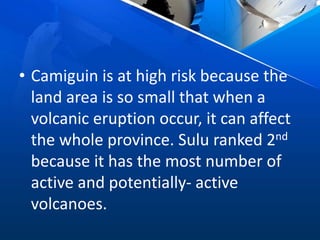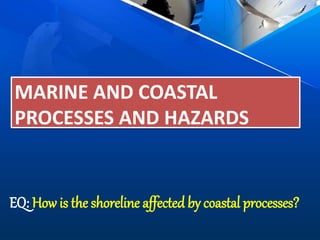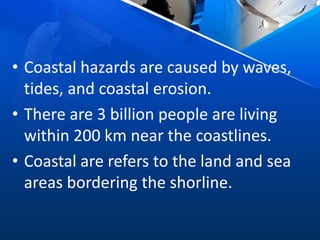Natural Processes and Hazards- ELS
- 2. How does the land affect us whenever it moves?
- 4. • Natural hazards- is naturally- occurring event or phenomenon which has negative anthropogenic and coastal processes could lead to natural disaster.
- 5. • Natural disaster- refers to any natural hazard or threat that causes fatality or damage to property.
- 6. • Hazard mitigation- minimization of risk. This involves learning and understanding how the natural processes operate.
- 9. • PHIVOLCS- Philippine Institute of Volcanology and Seismology, the government agency overlooking all seismic and volcanic activities in the Philippines, recorded 12 destructive earthquakes since 1968.
- 10. Top 10 provinces that are at risk to earthquakes 1. SURIGAO DEL SUR 2. LA UNION 3. BENGUET 4. PANGASINAN 5. PAMPANGA 6. TARLAC 7. IFUGAO 8. DAVAO ORIENTAL 9. NUEVA VIZCAYA 10.NUEVA ECIJA
- 11. • La Union and Pangasinan are prone to Earthquake, due to Manila trench while Surigao del Sur and Davao Oriental are at risk for earthquakes due to Philippine Trench and nearby active faults.
- 12. LANDSLIDES • When earthquakes happen in humanmade embankments and natural slopes in mountains areas, the hazard and potential devastation greatly increases
- 14. Top 10 provinces that are at risk to lanslides hazards 1. IFUGAO 2. LANAO DEL SUR 3. SARANGANI 4. BENGUET 5. MOUNTAIN PROVINCES 6. BUKIDNON 7. AURORA 8. DAVAO DEL SUR 9. DAVAO ORIENTAL 10.RIZAL
- 15. • Ifugao, Lanao del Sur, and Sarangani are highly vulnerable to landslide compared to Rizal. Despite the low vulnerability of Benguet, its high exposure factor or population density have made living in the region are more risky.
- 17. • The Philippines lies within the Pacific Ring of Fire. This explains the distribution of most volcanoes in the Philippines. • The mount Pinatubo eruption of 1991 was well known to be the most violent eruption the 20th century. • There are 22 historically active volcanoes distributed all over the Philippines.
- 19. Top 10 provinces at risk to volcanic eruptions 1. CAMIGUIN 2. SULU 3. BILIRAN 4. ALBAY 5. BATAAN 6. SORSOGON 7. SOUTH COTABATO 8. LAGUNA 9. CAMARINES SUR 10.BATANES
- 20. • Camiguin is at high risk because the land area is so small that when a volcanic eruption occur, it can affect the whole province. Sulu ranked 2nd because it has the most number of active and potentially- active volcanoes.
- 21. • TSUNAMIS- another caused by earthquakes or seismic activities that affect bodies of water.
- 22. Top 10 provinces that are at risk to tsunamis 1. SULU 2. TAWI-TAWI 3. BASILAN 4. BATANES 5. GUIMARAS 6. ROMBLON 7. SIQUIJOR 8. SURIGAO DEL NORTE 9. CAMIGUIN 10.MASBATE
- 23. • Sulu and Tawi-tawi are highly vulnerable to tsunami due to their being in between two nearby trenches (Sulu trench and Cotabato trench) and their dense population. • Most areas in Basilan and Romblon are at high at risk especially because they have been previously affected by a tsunami.
- 25. Northeast Moonsoon Southwest Moonsoon HABAGATAMIHAN MOONSOON- is a consistent reversal of wind pattern or a wind system generated by large weather system.
- 26. • PAGASA- Philippine Atmospheric Geophysical, and Astronomical Services- is the government weather bureau which monitor atmospheric occurrences within the Philippine area of responsibility, its internationally- recognized jurisdiction. • Tropical cyclones or bagyo are common in the Philippines due to its being in the typhoon belt. • PAGASA records an average of 20 tropical cyclones entering the PAR annually.
- 27. Tropical Cyclones and Wind Speeds TYPE SUSTAINED WIND NEAR THE CENTER Tropical depression 30- 60 km/h Tropical storm 61-88 km/h Severe tropical storm 89-117 km/h typhoon 118-219 km/h Super typhoon Faster than 220 km/h
- 28. Mitigation and Prevention • To mitigate the effects of tropical cyclones and flooding, PAGASA have implemented some measures. Floods and 3D hazard maps are made to disseminated to areas which are usually hit by typhoons and areas which are prone to flooding.
- 29. Public Storm Warning System Level Wind And Lead Time 1 30-60km/H ; Within 36 Hours 2 60-120km/H; Within 24 Hours 3 120-170 Km/H; Within 18 Hours 4 170-220 Km/H; Within 12 Hours 5 Faster Than 220km/H; Within 12 Hours
- 30. • Using PAGASA’s PSWS, the Department of Education (DepEd) has adopted the following guidelines with regards to class suspension: PSWS 1- All classes in kindergarten are suspended PSWS 2- All classes in elementary and high school are suspended PSWS 3- All classes in all levels, including college and graduate schools, are suspended
- 31. PAGASA also provide color-coded rainfall warning system
- 32. MARINE AND COASTAL PROCESSES AND HAZARDS EQ: How is the shoreline affected by coastal processes?
- 33. • Coastal hazards are caused by waves, tides, and coastal erosion. • There are 3 billion people are living within 200 km near the coastlines. • Coastal are refers to the land and sea areas bordering the shorline.
- 34. Submersion and Coastal Erosion • Waves, which are caused by wind and storms, cause large impacts around the coastline for the potential coastal erosion, flooding, and damages they may bring. • Tides, which are the result of the gravitational attraction of the sun and moon on the oceans, cause the frequent rise and fall of ocean levels.
- 35. • The processes of wave action, wave currents, and tidal currents wear away the land and removes sediments near the coastline. This effect is called coastal erosion. • Building seawalls which run parallel to the sea prevents the direct impact of coastal processes to landforms near he coast.
- 36. Salt Intrusion • When saline water moves into freshwater aquifers, which are the main source of drinking water in coastal areas, it often leads to contamination. • Intrusion of saltwater happens naturally because of the varying densities of saltwater and freshwater.



































